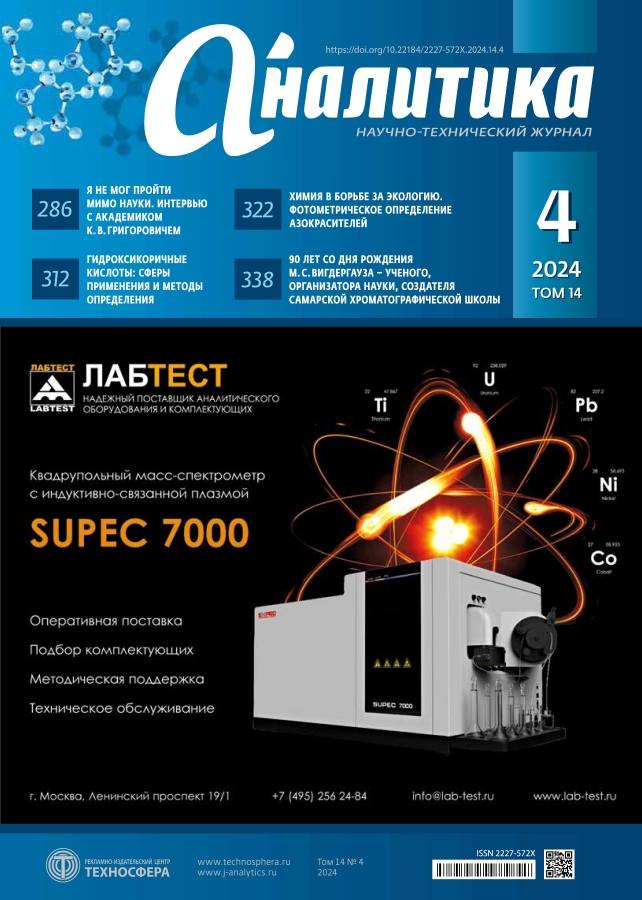Photometric Determination of Azodyes Based on Carbo- and Heterocyclic Alpha-Dicarbonyl Compounds
- Authors: Filenko I.A.1, Bubelo O.N.1, Bozhenkova S.S.2, Polyanskaya N.A.3, Kovalchukova O.V.3
-
Affiliations:
- Russian Institute for Scientific and Technical Information of the Russian Academy of Sciences (VINITI RAS)
- A. N. Kosygin Russian State University (Technology. Design. Art)
- Peoples’ Friendship University of Russia (PFUR)
- Issue: Vol 14, No 4 (2024)
- Pages: 322-326
- Section: Аналитика веществ и материалов
- URL: https://journals.eco-vector.com/2227-572X/article/view/637208
- DOI: https://doi.org/10.22184/2227-572X.2024.14.4.322.326
- ID: 637208
Cite item
Abstract
Until recently, synthetic organic dyes were considered micropollutants due to their low concentrations in the environment, but recent data indicate that dye pollution is becoming an increasing problem. The production process, determination of product quality parameters and environmental requirements require analytical control. The article describes new azo dyes based on carbo- and heterocyclic alpha-dicarbonyl compounds and presents the results of their determination by photometric method. Optimal absorption wavelengths of solutions of the compounds, specific absorption coefficients, detection limits and linear ranges of determination are established.
Full Text
About the authors
Igor A. Filenko
Russian Institute for Scientific and Technical Information of the Russian Academy of Sciences (VINITI RAS)
Author for correspondence.
Email: chemistf@mail.ru
ORCID iD: 0000-0002-4204-295X
Candidate of Technical Sciences, Senior Researcher at the Department of Scientific Information on Chemistry and Chemical Technology of the Department of Scientific Information on Chemistry and Materials Sciences
Russian Federation, MoscowOlga N. Bubelo
Russian Institute for Scientific and Technical Information of the Russian Academy of Sciences (VINITI RAS)
Email: bon199@yandex.ru
Candidate of Chemical Sciences, Head of the Department of Scientific Information on Problems of Chemistry and Material Sciences of the Department of Scientific Information on Chemistry and Materials Sciences
Russian Federation, MoscowSvetlana S. Bozhenkova
A. N. Kosygin Russian State University (Technology. Design. Art)
Email: bozhenkova_ss@mail.ru
Postgraduate Student
Russian Federation, MoscowNadezhda A. Polyanskaya
Peoples’ Friendship University of Russia (PFUR)
Email: polyanskaya_na@pfur.ru
Candidate of Chemical Sciences, Senior Lecturer
Russian Federation, MoscowOlga V. Kovalchukova
Peoples’ Friendship University of Russia (PFUR)
Email: kovalchukova-ov@rudn.ru
ORCID iD: 0000-0002-6684-5829
Doctor of Chemical Sciences, Professor of the Department of General Chemistry
Russian Federation, MoscowReferences
- García-González A. et al. Development of standardized method for the quantification of azo dyes by UV–Vis in binary mixtures. Analytical biochemistry. 2020. 608: 113897.
- Rawat D., Mishra V., Sharma R. S. Detoxification of azo dyes in the context of environmental processes. Chemosphere. 2016. 155: 591–605.
- Tkaczyk A., Mitrowska K., Posyniak A. Synthetic organic dyes as contaminants of the aquatic environment and their implications for ecosystems: A review. Science of the total environment. 2020. 717: 137222.
- Ziarani G. M. et al. Metal-free synthetic organic dyes. Elsevier. 2018.
- Paździor K., Bilińska L., Ledakowicz S. A review of the existing and emerging technologies in the combination of AOPs and biological processes in industrial textile wastewater treatment. Chemical Engineering Journal. 2019. 376: 120597.
- Cheibub A. M. S. S. et al. Development and validation of a multipurpose and multicomponent method for the simultaneous determination of six synthetic dyes in different foodstuffs by HPLC-UV-DAD. Food chemistry. 2020. 323: 126811.
- Protti M. et al. Co-solvents and mobile phase additives in HPLC. Liquid Chromatography. Elsevier. 2023. P. 283–321.
- Antunes M. et al. Liquid chromatography–mass spectrometry as a tool to identify adulteration in different food industries. Food toxicology and forensics. Academic Press. 2021. P. 123–180.
- Juhee P. et al. An update on the sample preparation and analytical methods for synthetic food colorants in food products. Food Chemistry. 2024. P. 140333.
- Chung S. W. C. Quantification of permitted synthetic colours in food by liquid chromatographic methods: A review on analytical methods and theirperformance. Food Additives & Contaminants: Part A. 2021. 38(10): 1636–1655.
- Robards K., Ryan D. Principles and practice of modern chromatographic methods. Academic Press. 2021.
- Urbain A., Simões-Pires C. A. Thin-layer chromatography for the detection and analysis of bioactive natural products. Encyclopedia of Analytical Chemistry. American Cancer Society: Atlanta, GA, USA. 2020. P. 1–29.
- Roddu A. K., Baharuddin S., Anggrainy H. Identification of Synthetic Dyes Red Syrup Beverage Products at Local City of Makasar with Thin Layer Chromatography Methode and Visible Spectrophotometry. Journal of World Future Medicine, Health and Nursing. 2024. 2(1): 160–170.
- Sherma J. Thin-layer chromatography in the determination of synthetic and natural colorants in foods. Advances in Chromatography. CRC Press. 2019. P. 109–135.
- Okeke E. S. et al. Analytical detection methods for azo dyes: a focus on comparative limitations and prospects of bio-sensing and electrochemical nano-detection. Journal of Food Composition and Analysis. 2022. 114: 104778.
- ГОСТ 32073-2013. Продукты пищевые. Методы идентификации и определения массовой доли синтетических красителей в алкогольной продукции. 2014. 28 с. GOST 32073-2013. Food products. Methods of identification and determination of the mass fraction of synthetic dyes in alcoholic beverages. 2014. 28 р.
- ГОСТ 32050-2013. Продукты пищевые. Методы идентификации и определения массовой доли синтетических красителей в карамели. 2007. 24 с. GOST 32050-2013. Food products. Methods of identification and determination of the mass fraction of synthetic colorants in caramel. 2007. 24 р.
- ГОСТ 31701-2012. Продукты пищевые. Метод определения наличия синтетических красителей в пряностях. 2014. 14 с. GOST 31701-2012. Food products. Method for determining the presence of synthetic colorants in spices. 2014. 14 р.
- ГОСТ 33279-2015. Консервы фруктовые. Определение наличия хинолиновых, триарилметановых и азокрасителей методом тонкослойной хроматографии. 2019. 12 с. GOST 33279-2015. Canned fruit. Determination of the presence of quinoline, triarylmethane and azo dyes by thin layer chromatography. 2019. 12 р.
- ГОСТ 20289-74. Реактивы. Диметилформамид. Технические условия. GOST 20289-74. Reagents. Dimethylformamide. Technical conditions.
Supplementary files









